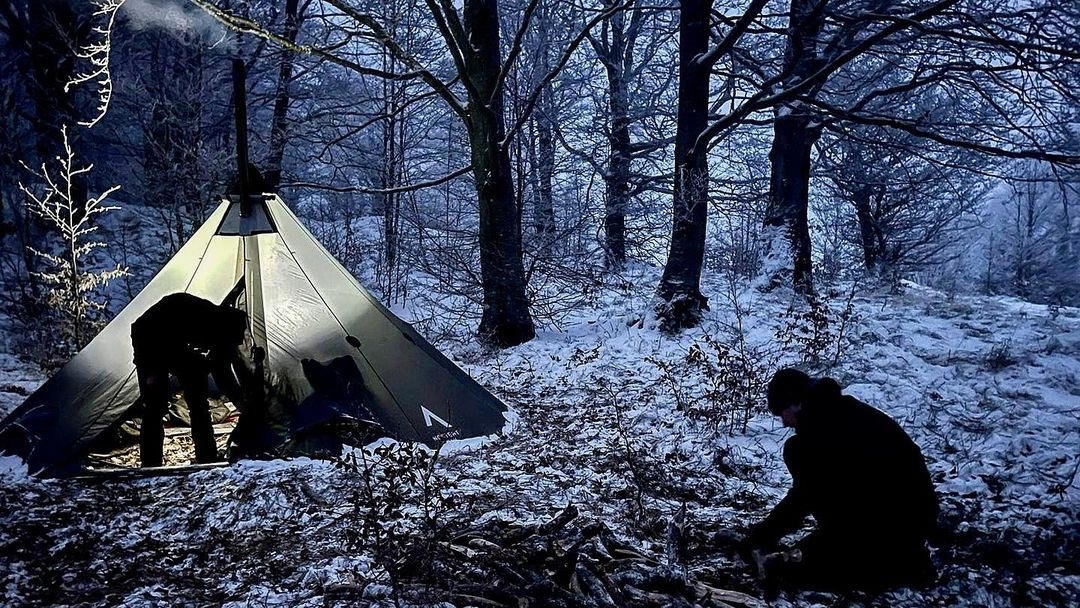Silnylon. Condensation. What about it?
Being able to feel warm, dry and safe in a tent is something we all prefer on an expedition. It goes without saying that it should be waterproof. One should not be worried about whether the tent can withstand the rain that hails against the tent during the night. Our nylon fabric are silicon-coated on both sides and are of course completely waterproof. It can withstand a water pressure of at least 3000 mm. This means that if you lay out the the fabric and shape it like a pool, you can fill this pool with water where the pool can be as much as 3 meters deep without the pressure of the water pushing the water through the fabric now laying on the bottom. If you now imagine our fabric at the bottom of this pool, there is quite a lot of water pressing against the fabric. Nevertheless. The fabric keeps the water in place. But if the surroundings/the air around the "pool" is cool and moist, and the water in the "pool" the colder, you will see water droplets on the "dry" side of the fabric, even if the fabric does not let water through. This is where we meet an important physical principle. And that is condensation.
When moist air hits the colder tent fabric, the air is unable to retain the same humidity, and the water in gaseous form is then left as liquid water on the inside of the outer fabric. The same principle applies when you get into your car on a rainy day. Then there is condensation/water on the inside of the windscreen. Or just look at the grass one random morning. It's full of water drops even though it hasn't rained a single drop. Same principle. Condensation is perhaps a particularly big challenge when it rains, because this air contains a particularly high amount of moisture/water... (There is a reason why it rains).
You are completely dependent on getting the moist air out of the tent to avoid condensation. In some cases, however, it is almost impossible to ventilate all the moist air. Especially on humid evenings where the temperature is low and the humidity high. In several cases, you will find that the battle against condensation is lost as the tent-walls gets wet on the inside. Regardless. If you do not have a wood stove and spend the night in a wet and cold climate, we would strongly recommend an inner tent (applies to all tents with artificial fibers such as nylon or polyester). That is precisely one reason why the vast majority of tents have fixed inner tents. But you certainly do not prevent condensation inside the tent with an inner tent. You only keep it outside the sleeping area. The inside of the outer fabric will still be just as damp and wet. You notice this if the inner tent comes into contact with the outer fabric on a perhaps rainy day.
Ventilation and heating are perhaps the best way to reduce condensation inside the tent. With proper ventilation, the moist air is replaced with dry air and transported out of the tent, preventing water droplets from forming on the inside of the tent fabric. But. When it rains, the air is saturated with moisture. This means we have 100% humidity. The same humidity then applies inside the tent. When this air then hits the inside of the cooled, thin tent wall, the saturated air is cooled very quickly and the air simply cannot hold the same amount of water. And it must then let go of the water. The water goes from gas to liquid (same principle when it rains outside). This phenomenon can be seen in the form of water droplets that runs down the inside of the tent wall. If the weather in addition is windy, the tent walls will flap where some of the water on the inside of the tent will be thrown off by the flapping fabric, on the inside of the tent. It feels as if it is raining through the tent walls. Of course it doesn't. This is called "misting" and is a well-known phenomenon when staying in a cooled tent without an inner tent on a rainy day















